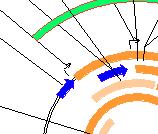Virology Theme Meeting 2008
Letter of Invitation:
On behalf of the Virology Theme, I invite you to register and to present your research at the Virology Theme Meeting, which is to be held on the 6-7th November, 2008. This meeting will provide an exciting forum for scientific interaction an opportunity for scientists, clinicians and students to present their virology-related research. Registration is free, as is the conference dinner. Both are sponsored by the University of Otago Virology Theme.
I have attached the registration and abstract submission form, due on the 15th October 2008. Please return the registration form if you wish to attend, even if you do not wish to give an oral or poster presentation. Speaking slots are 12 min + 3 min questions or 8 min + 2 min questions. Poster presenters will have the opportunity to give a 3 min oral presentation of their poster.
Yours sincerely,
Merilyn Hibma.
Meeting Organiser.
Abstracts of key plenaries:
We are very pleased to have two eminent international speakers, Prof. Saveria Campo from University of Glasgow and Dr David Tscharke from ANU, in addition to a number of other international speakers attending. Some information on the speakers is below:
How papillomaviruses evade the host immune response
Prof Saveria Campo
Institute of Comparative Medicine
University of Glasgow
The major research focus is the elucidation of how papillomaviruses evade the host immune response thus establishing a persistent infection and increasing the risk of neoplastic transformation of the infected cell. Better knowledge of these viral biological processes will provide the means of making the virus and the infected cell available to the host immune system for eradication by immune cells.
How T cells see Vaccinia Virus
David Tscharke
Dr David Tscharke
School of Biochemistry and Molecular Biology
Australian National University
The viral immunology laboratory studies large DNA viruses such as poxviruses and herpesviruses and how they are recognised and fought by the immune system. Our main focus at present is vaccinia virus (VACV), which is best known as the vaccine used to eradicate smallpox. More recently, recombinant vaccines based on vaccinia virus have been developed and are being tested in human clinical trials to prevent diseases as diverse as malaria, HIV/AIDS and some cancers. In addition, VACV has been using in mouse models for decades to study immune processes. Despite this history and potential, many aspects of immunity to VACV remain poorly understood. Indeed until the last few years, not a single T cell epitope was known for this virus in mice. We have been part of a larger consortium that has now mapped nearly 100 CD8+ T cell epitopes in the two most commonly used inbred mouse strains. In doing so we’ve been able to test the quality of epitope prediction algorithms and also to ask larger questions about the CD8+ T cell response, such as whether some proteins might be inherently more likely to be recognised by CD8+ T cells, irrespective of host MHC. We have also been able to see that for two different inbred mouse strains, responses are characterised as having a single dominant epitope that is recognised by at least 20% of all VACV-specific T cells and then a large number of less dominant epitopes. With this information hand we are now investigating how this profile of CD8+ T cell specificity arises. These considerations are important when designing recombinant vaccines because if a poxvirus vector is used, it is likely that the majority of CD8+ T cells elicited will recognise vector epitopes and not the recombinant antigen of interest.
In this context we have compared the immunogenicity of a range of well characterised epitopes from other viruses and the most dominant VACV epitope. In addition we are looking at the factors that contribute to the very high immunogenicity of this immunodominant epitope both in a laboratory strain of VACV and an attenuated strain (MVA) currently used as a vector in several clinical trials. Lastly, wanted to know how extra diversity in MHC class I genes affects CD8+ T cell responses to VACV, because in outbred human populations each individual expresses up to 6 different MHC class I proteins, whereas the inbred mouse strains used to model vaccination have as few as two MHC class I genes. While much of the data is new and not complete, we have evidence already that the rules for finding the best design for VACV-based vaccines may be less generic than currently thought and more dependant on the antigen being used.
Further Information:
Merilyn Hibma
Senior Research Fellow
Dept. Microbiology and Immunology
University of Otago
P O Box 56
(720 Cumberland St.)
Dunedin 9054
New Zealand
Ph. +64 3 479 7726
Fax. +64 3 479 7744
For the Virology Theme and meeting Committee: Assoc Prof Vernon Ward, Prof Andrew Mercer and Dr Chris Brown
Supported by the Virology Research Theme and Webster Centre.
|






